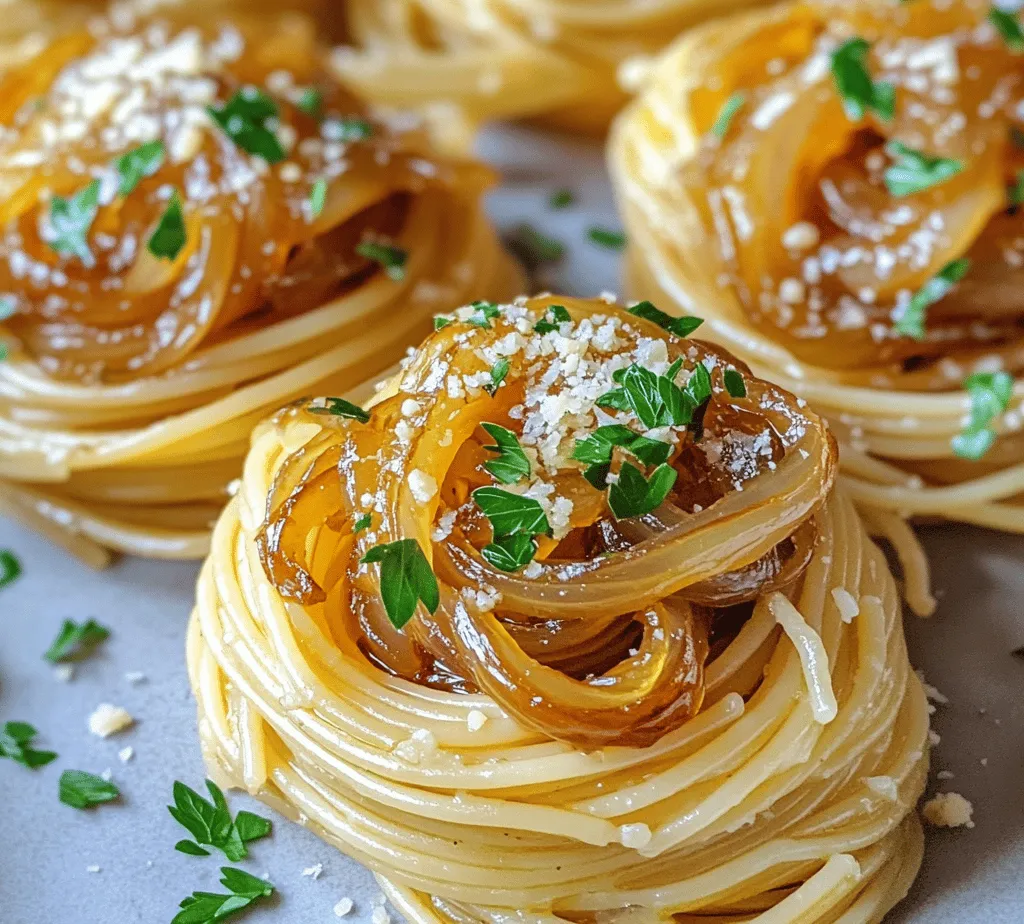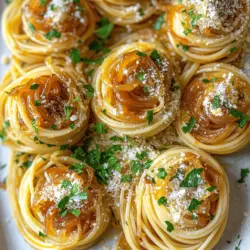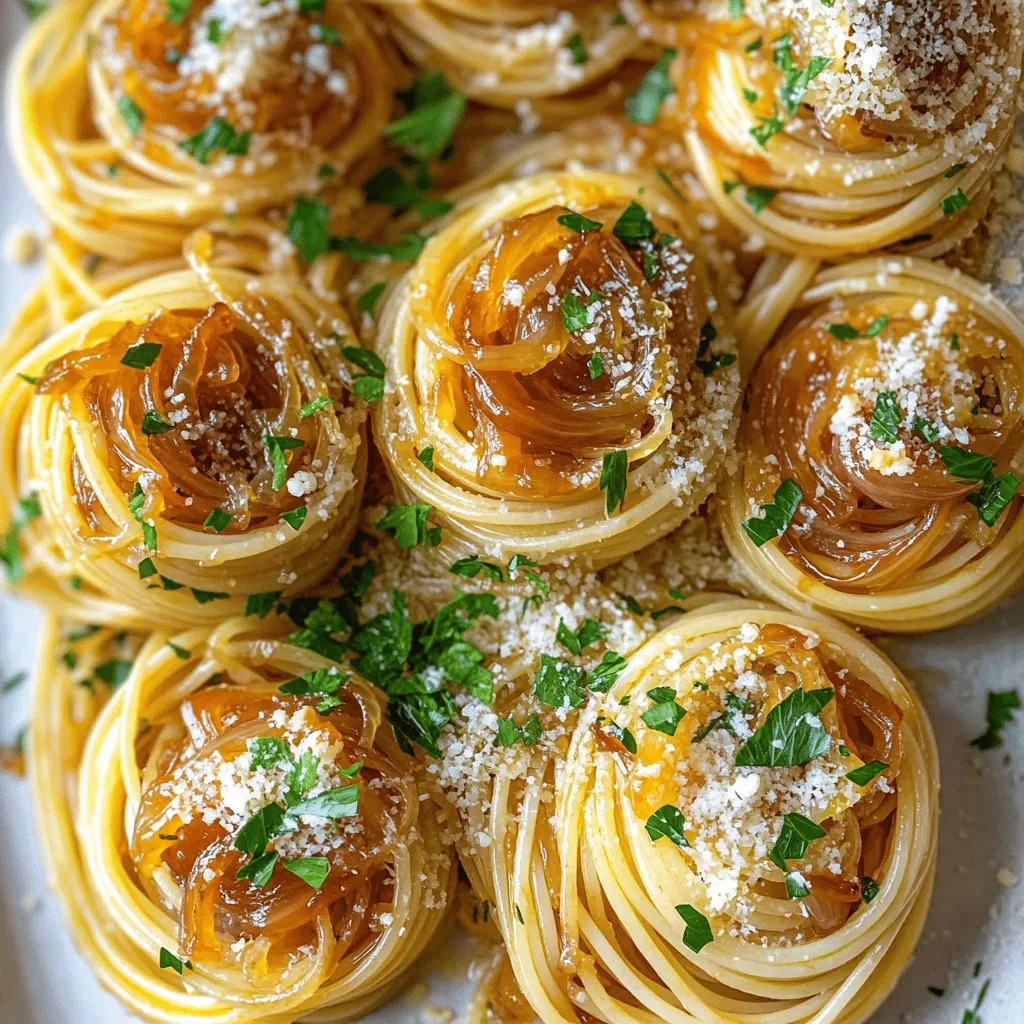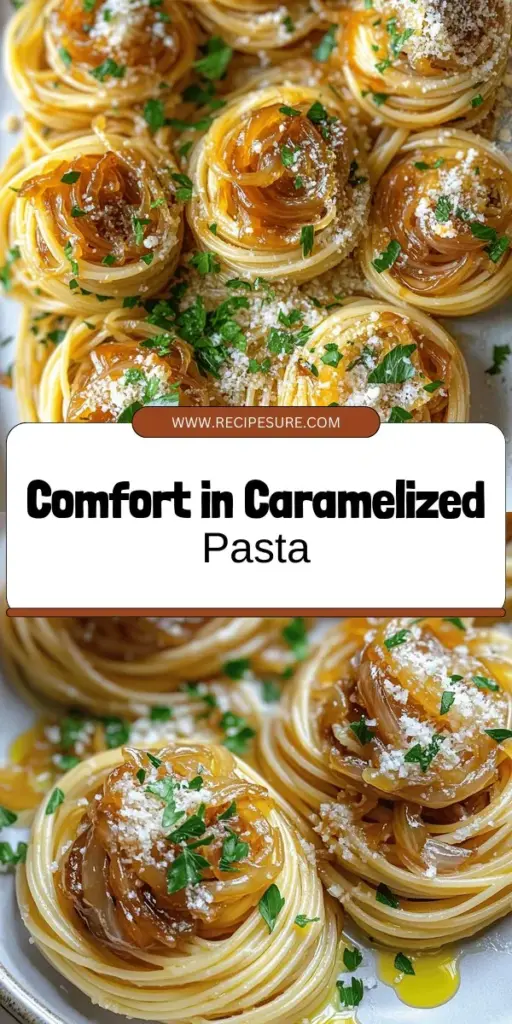Introduction
If you’re searching for a dish that embodies comfort and flavor, look no further than caramelized onion pasta. This delightful recipe has gained popularity among home cooks and food enthusiasts alike, thanks to its rich, savory profile and simplicity. The warmth of caramelized onions paired with your choice of pasta creates a dish that feels indulgent yet accessible—a true staple for busy weeknights or cozy gatherings.
Caramelized onions are the star of this dish, transforming a handful of basic ingredients into a luxurious meal. Their sweet, deep flavor adds a remarkable depth that elevates the pasta, making it not just a meal, but a comforting experience. Whether you’re cooking for family, entertaining friends, or simply treating yourself after a long day, this pasta dish adapts effortlessly to any occasion. With just a few ingredients and a bit of time, you can create a plate of pasta that’s not only satisfying but also incredibly delicious.
Understanding the Ingredients
To master caramelized onion pasta, you need to understand the ingredients that come together to create this dish. Each component plays a crucial role in the overall flavor and texture, ensuring you achieve the perfect balance.
Pasta Types
When it comes to pasta, your choice can significantly impact both the texture and presentation of the dish. Two popular options for this recipe are spaghetti and fettuccine:
- Spaghetti: This long, thin pasta is a classic choice for many dishes. Its sleek shape allows it to cling to the caramelized onion sauce, creating a delightful mouthful with every bite. Spaghetti’s neutral flavor complements the sweetness of the onions without overwhelming them.
- Fettuccine: If you prefer a broader noodle, fettuccine is an excellent alternative. This flat pasta has a slightly chewy texture that stands up well to sauces. It provides a heartier feel, making each bite more substantial and satisfying.
Choosing between spaghetti and fettuccine ultimately boils down to personal preference; however, consider that the broader surface area of fettuccine may hold onto the caramelized onion sauce better, resulting in a more cohesive dish.
Onions
The heart of this recipe lies in the onions—specifically, yellow onions. These versatile bulbs are known for their sweetness and flavor depth, which only intensifies as they cook. When caramelized, yellow onions undergo a transformation, releasing their natural sugars and developing a rich, golden-brown color. This process not only elevates their sweetness but also adds complexity to the dish.
The caramelization process involves slowly cooking the onions over low to medium heat. This gentle cooking allows the sugars to caramelize without burning, resulting in a beautifully rich flavor. It may take some time, but the reward is well worth the patience.
Olive Oil and Butter
The fats you choose for cooking are just as important as the ingredients themselves. In this recipe, a combination of olive oil and butter is used. Olive oil brings a fruity, peppery flavor that complements the sweetness of the onions, while butter adds richness and a silky texture to the sauce.
Using both fats not only enhances the flavor profile but also helps prevent the butter from burning at higher temperatures. For the best results, opt for a high-quality extra virgin olive oil and unsalted butter to control the saltiness of the dish.
Garlic and Herbs
Garlic is a key player in this recipe, adding aromatic notes that pair beautifully with caramelized onions. When sautéed, garlic releases its essential oils, providing a fragrant backdrop to the dish. Fresh garlic is recommended for maximum flavor, but if you’re in a pinch, garlic powder can be a suitable substitute.
Herbs also play an important role in flavoring the pasta. Fresh thyme is an excellent choice, as its earthy notes enhance the overall taste while providing a hint of freshness. Dried thyme can be used as well, but remember that dried herbs are more concentrated, so use them sparingly. Fresh herbs not only taste better but also add a lovely visual appeal to the finished dish.
Parmesan Cheese
No pasta dish is complete without a sprinkle of cheese, and Parmesan is a perfect match for caramelized onion pasta. This hard cheese is known for its nutty, savory flavor and adds richness to the dish. When grated and tossed with the warm pasta, it melts slightly, creating a creamy texture that binds the ingredients together.
When selecting Parmesan, aim for a high-quality cheese, preferably aged for a robust flavor. Look for cheese that is labeled “Parmigiano-Reggiano,” as it guarantees authenticity and superior taste. If you’re feeling adventurous, consider grating some fresh cheese directly over the pasta just before serving to elevate the dish even further.
Step-by-Step Instructions
Cooking caramelized onion pasta might seem straightforward, but there are some essential steps to ensure your dish comes out perfectly every time. Here’s a detailed guide to help you through the cooking process.
Cooking the Pasta
1. Bring a Large Pot of Water to a Boil: Start by filling a large pot with water and bringing it to a rolling boil. This is crucial for cooking the pasta properly.
2. Season the Water: Once the water is boiling, add a generous amount of salt—about 1-2 tablespoons. This step is vital as it helps to flavor the pasta itself. Remember that the water should taste like the sea.
3. Add the Pasta: Carefully add your chosen pasta to the boiling water. Stir immediately to prevent sticking.
4. Cook Until Al Dente: Refer to the package instructions for cooking time, but typically, you’ll want to cook the pasta until it’s al dente—firm to the bite. This usually takes about 8-10 minutes, depending on the type of pasta. To check for doneness, taste a piece a minute or two before the package’s suggested time.
5. Reserve Pasta Water: Just before draining the pasta, reserve about a cup of the starchy cooking water. This liquid will come in handy later for adjusting the sauce consistency.
6. Drain and Set Aside: Drain the pasta in a colander and set it aside. Do not rinse the pasta, as this will wash away the starches that help the sauce adhere.
With the pasta prepared, you’re ready to move on to the heart of the dish: caramelizing the onions and combining the flavors that will make this recipe a standout. Stay tuned for the next steps, where we will delve deeper into the cooking process and finalize this comforting dish!

Caramelized Onion Pasta
Caramelizing the Onions
Caramelizing onions is the heart of this dish, as it brings out their natural sweetness and adds depth to the flavor profile. To achieve perfectly caramelized onions, start by slicing them thinly. The thinner the slices, the more evenly they will cook. Use a heavy-bottomed skillet to ensure even heat distribution.
Techniques for Perfect Caramelization
1. Heat Management: Start with medium heat to allow the onions to soften without burning. Once they are translucent and starting to brown, reduce the heat to medium-low. This will slow down the cooking process, allowing the sugars in the onions to caramelize beautifully without burning.
2. Stirring: Stir the onions every few minutes to promote even cooking. If they start to stick to the pan, add a splash of water or broth to deglaze the pan. This will lift the fond (the caramelized bits stuck to the bottom) and incorporate those flavors back into the onions.
Troubleshooting Tips for Stuck Onions
If you find your onions sticking to the pan:
- Add Liquid: A small amount of water, broth, or even a splash of white wine can help release the onions from the pan.
- Adjust Heat: If the heat is too high, it can cause the onions to burn. Lower the heat to avoid this.
- Use a Non-Stick Skillet: If you consistently have trouble, consider using a non-stick skillet for easier release and cleanup.
Adding Flavor with Garlic and Seasonings
Once your onions are perfectly caramelized, it’s time to elevate the dish with garlic and seasonings.
Timing and Techniques for Adding Garlic
Garlic burns quickly, so timing is crucial. Add minced garlic to the skillet with the onions during the last 2-3 minutes of cooking. Stir continuously to prevent it from burning, which can impart a bitter taste to your dish.
Adjusting Spice Levels with Red Pepper Flakes
For those who enjoy a bit of heat, red pepper flakes are an excellent addition. Start with a pinch, and adjust to your desired spice level. Adding them when you introduce the garlic allows the oils from the spices to infuse into the onions, creating a flavor explosion in every bite.
Combining Pasta and Sauce
After your onions and garlic are ready, it’s time to combine them with the pasta for an integrated dish.
Techniques for Properly Mixing Pasta and Sauce
1. Reserve Pasta Water: Before draining your pasta, reserve about a cup of the cooking water. This starchy water will help to thicken the sauce and bind it to the pasta.
2. Mixing: In the skillet with the caramelized onions, add the drained pasta and a splash of reserved pasta water. Toss everything together over low heat, allowing the pasta to absorb the flavors. The starch in the pasta water will create a silky sauce that coats the noodles evenly.
3. Taste and Adjust: At this stage, taste the dish and adjust the seasoning as needed with salt and pepper.
Finishing Touches with Cheese
To add richness and a creamy texture to your pasta, cheese is a must.
Tips for Melting Cheese into the Pasta
- Choose the Right Cheese: Parmesan is a classic choice, but you can also use pecorino or a mild goat cheese for a different flavor profile.
- Add Gradually: Stir in grated cheese gradually, allowing it to melt into the pasta. If the pasta seems dry, add more reserved pasta water as needed to achieve your desired creaminess.
- Finish with a Pat of Butter: For an extra layer of richness, stir in a small amount of butter just before serving.
Presentation and Serving Suggestions
How you present your caramelized onion pasta can elevate the dining experience.
Ideas for Plating the Pasta Attractively
- Twirl and Pile: Use a fork to twirl individual servings of pasta onto plates, creating a nest-like presentation.
- Layering: Layer the onions on top of the pasta for a visually appealing dish that showcases the key ingredient.
Suggestions for Garnishing
- Fresh Parsley: A sprinkle of chopped fresh parsley adds a pop of color and freshness to the dish.
- Drizzle of Olive Oil: A final drizzle of high-quality olive oil enhances the flavor and adds a glossy finish.
Pairing Recommendations
This pasta pairs beautifully with various accompaniments:
- Wine: A crisp white wine, such as Sauvignon Blanc or Pinot Grigio, complements the sweetness of the onions.
- Side Dishes: A simple green salad with vinaigrette or roasted vegetables provides a balanced meal.
Nutritional Information
Understanding the nutritional breakdown can help you enjoy your meal more mindfully.
Overview of Calories and Nutritional Breakdown
On average, a serving of caramelized onion pasta contains approximately 400-500 calories, depending on the amount of cheese and oil used. Here’s a general breakdown per serving:
- Carbohydrates: 60g
- Protein: 12g
- Fat: 15g
- Fiber: 4g
Discussion of Health Benefits
The primary ingredients in this dish provide several health benefits:
- Onions: Rich in antioxidants and vitamins, they support heart health and boost immunity.
- Garlic: Known for its anti-inflammatory and immune-boosting properties.
- Olive Oil: A healthy fat known for its heart health benefits and anti-inflammatory effects.
Suggestions for Modifications for Dietary Preferences
- Vegetarian: This recipe is vegetarian; however, ensure that the cheese you use is rennet-free if strict vegetarianism is followed.
- Gluten-Free: Substitute traditional pasta with gluten-free pasta varieties made from brown rice, quinoa, or legumes.
Culinary Tips and Variations
Experimenting with this recipe can lead to delightful new flavors.
Ideas for Customizing the Recipe
- Adding Proteins: Incorporate grilled chicken, shrimp, or chickpeas for added protein.
- Including Vegetables: Spinach, peas, or roasted bell peppers can add color and nutrition to your dish.
Seasonal Variations
Utilize seasonal vegetables to create variations:
- Spring: Add asparagus or peas.
- Summer: Incorporate zucchini or fresh tomatoes.
- Fall: Consider adding butternut squash or mushrooms.
Suggestions for Making a Larger Batch for Meal Prep
This recipe is easily scalable. Double the ingredients and prepare a larger batch. Store leftovers in an airtight container in the refrigerator for up to 3 days. Reheat gently on the stovetop, adding a splash of water or broth to loosen the sauce.
Conclusion
Caramelized onion pasta is a beautiful embodiment of simplicity and comfort, marrying the rich sweetness of caramelized onions with the creamy goodness of cheese. This dish invites you to experiment with flavors and ingredients, making it a versatile staple in any home cook’s repertoire.
Whether you’re preparing a quick weeknight meal or impressing guests at a dinner party, this recipe is sure to delight. Embrace the joy of cooking and sharing meals with loved ones, and don’t hesitate to put your unique spin on this delicious dish. Enjoy every bite!


